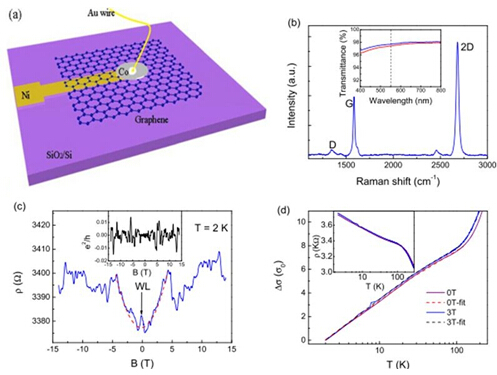Suzhou Graphene Nanotech. Co., Ltd. research team cooperating with Institute of Suzhou Nanotech., Chinese Academy of Sciences (CAS), proposed a new asymmetry Ni/graphene/Co sandwich vertical structure device. The novelty of this device is that it possesses both the vertical channels and the horizontal channels. It was observed that WL and EEI at relative high temperature regime and was concludes that the EEI is the main mechanism of dephasing at low temperature regime. The spin valve effect was observed when the magnetic field was parallel to the sample. The significance of this finding opens a way to the study of electron correlation and spin transport at relatively high temperatures. The results have been published in Applied Physics Letters 104, 153114 (2014).
In an asymmetry Ni/graphene/Co vertical spin transport device, since the easy axis of magnetization in parallel to the electrode film, the EEI and weak localization (WL) is observed when the direction of the magnetic field is perpendicular to the sample plane. The presence of EEI and WL at moderate temperatures up to ~120 K can be attributed to the new structure of the device with short electron and spin channels that reduce the probability of scattering during the transport. From the expected logarithmic temperature dependence, the coefficient of the interaction was obtained as and we found the Fermi liquid constant at magnetic field of 3 Tesla and WL suppressed. These results are consistent with the theoretical value of and the linear temperature dependence decoherence rate indicates that the EEI is the main dephasing mechanism in our devices at low and moderate temperature ranges.

When we applied magnetic field parallel to the graphene surface, we observed that the spin valve effects in the vertical structure devices. High resistance states at low field regions corresponded to the circumstance that the magnetization directions of two electrodes are opposite since the coercive forces were different. It leads to a change of the low Rp state to the high Rap state, during sweep of magnetic fields.

 HOME
HOME  中文版
中文版 English
English
